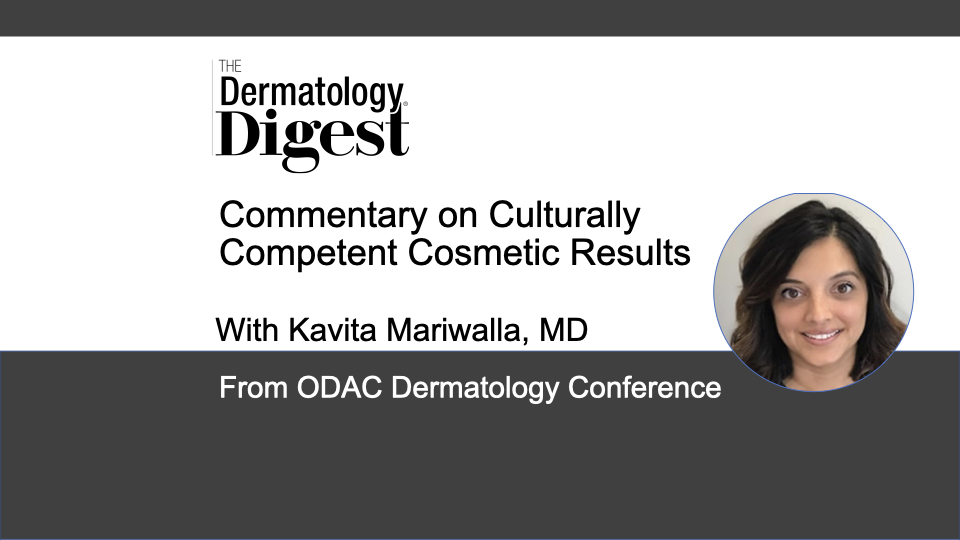Dr. Kavita Mariwalla provides insights and advice for safely and effectively caring for diverse patients.
Kavita Mariwalla, MD, Double Board-Certified Dermatologist, Mariwalla Dermatology, West Islip, New York
“When we talk about culturally competent cosmetic evaluations, the first thing I try to explain to people is to not just use your eyes. Because now more than ever patients come in and you cannot just assume where they’re from or their ethnic makeup based on their skin tone or type,” said Kavita Mariwalla, MD, who presented “Culturally Competent Cosmetic Results” at this year’s ODAC Dermatology Conference.
“I’ll give you an example. My nephews and niece are half South Asian. If you looked at them, they have Caucasian skin and red hair—no characteristics that signal they are half Indian. Yet, if you tried to IPL their freckles, they would scar and hyperpigment like the South Asian people that they are.”
This underscores the need to understand more and assume less in a world that not only is getting smaller, but also becoming increasingly interracial, Dr. Mariwalla said.
“You can’t just say, ‘Oh, you look like a skin type 3, let me treat you like that.’”
Ask for photos of the patient and their parents during the consult and craft an appropriate phrase to learn more about their cultural background, advised Dr. Mariwalla.
“Nobody’s going to say, ‘Oh, where are you from?’ Because if somebody asked me, I would say, ‘I’m from Long Island.’ Take the time to think about and practice the phrase that feels comfortable for you and not cringy.”
According to Dr. Mariwalla, hers is, “Can you tell me a little bit about your cultural background?”
“I like the phrase ‘ethnic heritage’ too, because in the United States everybody’s from somewhere else.”
Family photos of the patient when he or she was younger can also provide clues to what may contribute to skin tone, sun exposure, and ethnic heritage, said Dr. Mariwalla.
‘Beauty’ Bias
“And then I think it’s important to remember or recognize all of the ways that we’ve been taught about injections. Injection techniques are typically based on a White European model.”
Case-in-point the Ricketts line, traditionally considered a standard measurement of beauty for the nose-lips-chin profile angle, said Dr. Mariwalla.
“If you’re, for example, East Asian, your nose doesn’t have this protrusion. So how are you going to make a Ricketts line…? So just recognizing the bias that we have even in our teaching is really important.”
Culturally Appropriate
According to Dr. Mariwalla, it’s important to remain culturally appropriate when making changes to specific facial anatomy.
“Where the most variability comes in is the nose and lips. So make sure that if you’re changing those factors on people, whether you’re advising them to get a rhinoplasty, or you’re doing a liquid rhinoplasty, or you’re changing their lip shape, that it’s appropriate from the region of the world that they’re from because that’s the most variable across different backgrounds.”
Another important consideration during the cosmetic consult is everyday wear, said Dr. Mariwalla.
“…a lot of times you’ll see somebody in the exam room and they’re not wearing what they always wear, so a typical example is like a hijab or niqab. If they’re a woman and they’re coming to see me, well, they would take that off in the exam room. But if they’re always wearing a hijab [and] … I slim out their face they will actually look worse in what they wear all day long.”
Meet Patients Where They Are
Being able to deliver culturally competent cosmetic results requires meeting patients where they are and having those conversations, said Dr. Mariwalla.
“…ask them, what do you like to do? What kind of clothes do you wear? What’s your ethnic heritage? Because there are different facial cannons for each region of the world.”
Treating diverse patients requires learning about them, said Dr. Mariwalla.
“My best advice is to make sure you just keep reading. People want to know, oh, where can I find out that information? American literature is not the only literature out there. Every country has journals that they submit to: South Asians have it. Chinese have it. Japanese have it. Koreans have it, especially when it comes to toxin.”
You will need to seek this information out because it isn’t typically provided in textbooks, said Dr. Mariwalla
“So make sure as our globe gets smaller and you see more and more diverse patients in your practice, if you’re going to claim that you can treat diverse patients, take the time to read and learn what looks best on them.”


